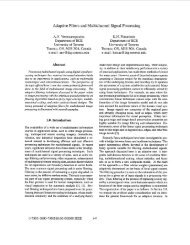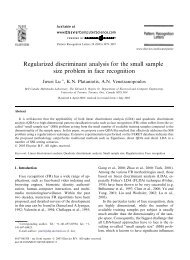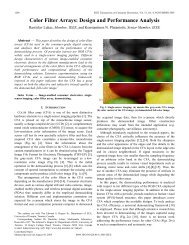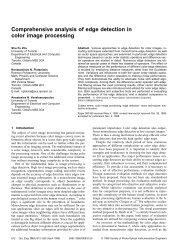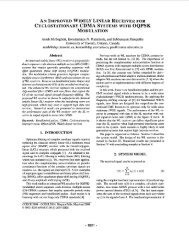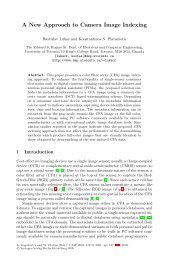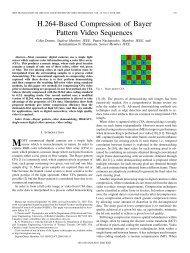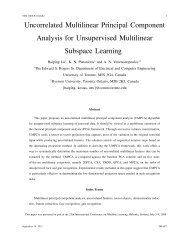has advantages over the time-domain approach. Specifically,since the transform is calculated in increments of the angularfrequency 2π/T, signals extracted from gait sequences withdifferent walking periods are directly comparable. In practice,however, not all frequency components are useful for recognition.This is why there are methods that use only the magnitudeand phase of the Fourier transform at the fundamentalwalking frequency [30], [44].In [44], it was stated that all motions in a gait cycle sharethe same fundamental frequency, and a system was proposedwhich uses optical flow for measuring shape oscillations. Asignificant conclusion reached in [30] was that frequency signaturesyielded superior performance in cases where the comparedgait sequences were captured on different days (and,therefore, the structural information alone was not reliable).This provides an additional motive for investigating frequency-domainfeatures.In the experimental assessment section, we will evaluate theperformance of a simple scheme based on the direct transformationof features. In this system, the entire feature time series isexpressed as a single complex feature vector through application of(4). In Figure 6, we display such a representation using silhouettes.DIMENSIONALITY REDUCTIONA natural question arises in the context of gait analysis: Howmuch information do we need to extract from a gait sequence inorder to capture most discriminative information?On the temporal axis, it appears that shape information can becaptured using four or five characteristic frames [14], [32] or featurevectors. However, the frames or feature vectors themselvescould be represented in a more compact way. Since several of theelements in the feature vectors, extracted using the techniques inthe previous sections, usually contain information that does notcontribute to the purpose of recognition, methodologies such asprincipal component analysis (PCA) [43], [24], [27] or linear discriminantanalysis (LDA) [24] are used to retain only the importantelements of the original feature vector. Analysis of variance(ANOVA) can also be used for the identification of the significantcomponents in a gait feature vector. Several works achieve goodperformance using holistic features of dimension as low as 100.On the other hand, feature vectors consisting of model parameterswould carry more information than feature vectors extractedusing a holistic method. This is the reason why, for model-basedapproaches, the required coefficients might be fewer provided thatthe model parameters can be determined accurately (which is thereal challenge in model-based approaches).PATTERN MATCHING AND CLASSIFICATIONOnce gait information is extracted from gait sequences and theassociated feature vectors are formed, the actualrecognition/classification task must be performed. Two mainapproaches can be taken, namely, a template-based approach ora stochastic approach. In both cases, an appropriate distancemetric between feature vectors must be initially defined. Theclassical Euclidean distance is the measure that is used in mostgait recognition applications. Other measures are the innerproduct distance [32] and the number of “ones” in the binarydifference between frames [23]. A variety of other distance measuresmay also be used [45]; however, in this work, we use theclassical Euclidean distance in the implementations of the presentedgait methodologies.TEMPLATE MATCHINGThe main concern in calculating distances between different gaitrepresentations (templates) is whether we compare correspondingquantities in the two representations. In case of frequencytemplates (e.g., harmonic components computed using Fourieranalysis), the calculation of the distance between two templatesis straightforward since the correspondence between frequencycomponents in different templates is obvious. In this case, a frequencycomponent in one template should be compared with thecomponent in the same spectral position in the other template.In the case of spatial templates, the gait representation is asequence of features that must be compared with anothersequence of features. When the fundamental walking periods T 1and T 2 of the two sequences are not equal, their cumulative distanceover a gait cycle is defined asD 12 = 1 T∑u(t)D(f 1 (w 1 (t)), f 2 (w 2 (t))),Ut=1where the pairs (w 1 (t), w 2 (t)) define a warping function, u(t) is aweighting function, U = ∑ Tt=1 u(t), and D(·) denotes the distancebetween the feature vectors at time t. Based on the characteristicsof the warping function, we can distinguish three approaches forthe calculation of distances between feature sequences.The direct matching approach can be regarded as a brute-forceattempt to match a pattern consisting of feature vectors (derivedfrom frames in a gait cycle) by sliding it over a sequence of feature(a)(b)[FIG6] Frequency signatures: a complex silhouette templatecomputed as the Fourier transform of the gait sequence at thefundamental frequency. (a) Real part and (b) imaginary part.IEEE SIGNAL PROCESSING MAGAZINE [85] NOVEMBER 2005
T 2Having computed the distances between a test subject andall subjects in a reference database, the recognition decision istaken asidentity(i ) = arg min D ij , jwhere D ij denotes the cumulative distance between the i thtest subject and the jth reference subject. This means that theidentity of the test subject is assumed to be the identity of thereference subject with which the test subject has the minimumdistance.T 2T 1(a)T 2T 1(b)T 1vectors of the reference sequence to find the position that yieldsthe minimum distance. This is the approach taken in the baselinemethod created at USF [23]. However, this approach is clearly notsuitable for a gait recognition system since it implicitly assumesthat the periods of the gait cycles in the test and referencesequences are identical. Therefore, two sequences depicting thesame person walking at different speeds would appear dissimilar.The use of time normalization [46] is a more reasonableapproach since reference and test sequences corresponding tothe same subject may not necessarily have the same gait period.Consequently, if recognition is to be performed by templatematching, some kind of compensation would have to be appliedduring the calculation of the distance. To this end, dynamictime warping (DTW) [46] can be used to calculate the distancebetween a test sequence and a reference sequence. Using DTW[43], [38], all distances between test and reference frames arecomputed and the total distance is defined as the accumulateddistance along the minimum-distance path (termed the optimalwarping path). Another option is to use linear time normalization.Experiments demonstrate that linear time normalizationrivals the performance of DTW. This conclusion is in contrast toour intuitive expectation based on speech recognition paradigms,in which DTW was reported to be much more efficientthan linear time normalization [46]. The above approaches fortemplate matching are depicted in Figure 7.(c)[FIG7] Approaches for the matching of different sequences.(a) Direct, (b) dynamic time warping, and (c) linear time normalization.STATISTICAL APPROACH: HMMSUsing the template matching approaches outlined in the previoussection, the extent of similarity between walking stylesis quantitatively described using distances based on a distancemetric. This is a disadvantage; on one hand, such distancesmay not have a clear interpretation whereas, on theother hand, the pattern of states related to the succession ofstances during walking is not explicitly taken into account.For the above reasons, stochastic approaches such as HMMs[47] can also be used for gait recognition [32], [48]. In practicalHMM-based gait recognition, each walking subject isassumed to traverse a number of stances (see Figure 8). In otherwords, each frame in a gait sequence is considered to be emittedfrom one of a limited number of stances. The a priori probabilities,as well as the transition probabilities, are used to definemodels λ for each subject in a reference database. For a testsequence of feature vectors ˜f i , the probability that it was generatedby one of the models associated with the databasesequences can be calculated by( )P ˜fi /λ j , j = 1,...,N,where N is the number of subjects in the reference database. Thesubject corresponding to the model yielding the higher probabilityis considered to be identical to the test subject, i.e.,identity(i ) = arg maxj( )P ˜fi /λ j , j = 1,...,N.The HMM-based methodology is, in many aspects, preferable toother techniques since it explicitly takes into consideration notonly the similarity between shapes in the test and referencesequences, but also the probabilities with which shapes appear andsucceed each other in a walking cycle of a specific subject.From LastState[FIG8] A left-to-right hidden Markov model for gait recognition.To FirstStateEXPERIMENTAL ASSESSMENTTo evaluate the efficiency of the maingait analysis and recognitionapproaches that were presented previously,we considered several features,as well as both the template matchingand statistical approaches for theIEEE SIGNAL PROCESSING MAGAZINE [86] NOVEMBER 2005



